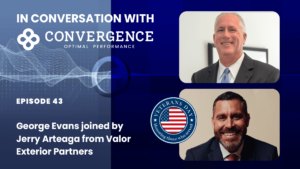With the tumultuous financial environment of the last few years, fund administrators and other service providers are finding themselves seen by many in a new light. With the ongoing “war on talent”, many firms are finding that outsourcing a service is more effective, not only on a dollar-for-dollar basis, but also in terms of managing capacity and keeping the firm focused. However, just as an adviser may decide to outsource middle or back-office duties, a service provider must similarly decide the scope of what they can provide to a client. As more clients are looking for consolidated services, the question of scope or specialization is at the forefront of our discussion.
We explore the recent developments in fund administration with founder and CEO of GP Fund Solutions Glen Shields, who discusses the trade-offs of consolidating as a service provider, and what’s on the horizon for 2023.
This blog’s insights are based on Episode 19 of our In Conversation with Convergence podcast, hosted by Convergence Co-Founder and President, George Evans. In this episode, George is joined by guest speaker Glen Shields from GP Fund Solutions, who discuss trends in fund administration, the choice between consolidation and specialization presented by bolt-on services, and expectations for 2023. Listen via the Convergence website or scroll down to continue reading the blog.
GP Fund Solutions over 11 years
Starting back in 2011 with two simple principles: building a great culture and delivering high quality service through technology, GP Fund solutions has seen consistent organic growth over the past decade by sticking to these core ideas. The firm mostly focuses on closed-end funds, servicing private equity, growth equity, venture capital and debt managers. GP specializes in firms looking for an institutional level back office, with fund sizes between $500 million and a few billion dollars. Emerging managers in particular are a good fit for GP, as over 65% of their clients are “fund one clients”, who they look to further establish before their next fund. After 11 years, and now with over 90 employees and nearing 50 billion of assets under administration, Glen Shields shares what has helped the firm navigate through the changes of the last few years.
Costs of Consolidation
The headline trend is consolidation. With service providers having the goal of building long-term relationships with a firm, it makes sense logically to add on a service from a provider you already know. While this may attempt to circumvent the typical challenges that come with any merger or acquisition, such as merging service models, technology, and culture, it presents other issues. While your service provider may be willing to extend their offerings beyond what they traditionally provide, it may mean they are working in a less familiar space. These challenges are only amplified in a fast-moving service model, or one experiencing a lot of growth or changes.
This leaves managers with the question: What’s most important to them? Is it really high-quality fund administration, or is it a firm that can do everything under the sun? While managers are doing this evaluation themselves, it is just as important that fund administrators and other service providers are doing this same type of introspection. As Glen Shields puts it, “I think [there is] an opportunity for all of us to reflect on where we fit in that model, [to understand] which question do we answer?”
If the distinction between a ‘do-it-all’ firm and a specialist firm is one market trend, the other may be that nearly 30% of closed-end funds are still self-administered, representing 30-40 thousand funds. We may expect for this distribution to change with the “war on talent”, as many managers who have traditionally preferred an in-house model may find outsourcing is the most effective solution to the capacity problem many are facing. But they’ve been hesitant to do so already for good reasons. Can an outsourced service provider perform not only in terms of baseline efficiency, but build a real partnership with the firm? And, to tie in the first trend, is the outsourced firm keeping up with their own capacity?
As is expected, the winners in these scenarios are funds and providers who plan and communicate at the highest level. It takes honesty about these questions of capacity and capability for both groups to understand what they can do for one another. Fund administration is at its best not just as an ‘on-off’ relationship, but as an ongoing collaboration between the two firms.
Fund Administration in Specialty Funds
How should administrators approach specialty funds, such as SPVs, crypto, or other digital assets? Mr. Shields reiterated that finding a good fit is essential. If you have the systems, the processes, and the technology in place (or can easily adapt it), then you can feel confident that you’ll be able to do what the fund requires of you. But tread carefully, as specialty funds often hold complexities, such as liquidation features, which can make fitting them into an existing set of procedures difficult. In certain categories, like crypto, it may be more prudent to get an expert before servicing those products, as an industry point of view can provide critical insight and make sure the firm doesn’t overextend itself. Plenty of assets have enough nuance that may manifest themselves in the waterfall model, in tax withholding issues, or other situations, that make having a specialist on board worth the cost.
Bolt-on Services and Scope of the Business
To further examine our earlier point about consolidation, let’s look more specifically at fund administration. One of the prevailing trends among administrators is the idea of ‘bolt-on’ services, or other services outside of core fund administration. This can include areas like managed IT, cybersecurity, compliance services, and tax, as the challenges of finding a good mix of culture and fit across several outsourced services is fatiguing.
One hand, this speaks to the trust that clients have in their fund administrators and the significance of building a really engaged relationship with your clients. It’s good to hear that the client likes your work so much that they want you to help them with other problems not traditionally within the purview of a fund administrator. As he previously mentioned, Glen holds to the principle that administrators should only engage in these extra services if they can be great at them and solve problems for the client rather than creating more issues by venturing outside the firm’s area of expertise.
For example, in the case of GP Fund Solutions, a natural add-on was data. Employees of back and middle office clients are facing more demand in this area, and GP already had a lot of the data investors were looking for. So, expanding the business to include data analytics and other tools is both demanded by the clients and fits the skill set of GP.
In contrast, AML services are another bolt-on request GP often receives. Glen recognizes that for his firm, it would be better to partner with an expert rather than GP provide AML service itself. In this case, Glen noted that GP can play into the role of a middleman, moving documentation and data between clients and the third-party AML provider, as an intermediary and white-labeled solution. In a way, the client is outsourcing their due diligence work in this case, and they trust GP to find that high-quality provider as part of their own resource network.
Lastly, Glen notes that for GP, the key has been honesty with their decisions and leveraging their independence. “I can make that distinction between creating enterprise value for the sake of creating enterprise value versus intentionally creating high quality services that really align with those sorts of initial fundamentals of why I started the firm, you know, good culture, good people, great service. So, I don’t really have a competing demand other than those original core values.”
Fund Administration in 2023 – Balance and Resilience
Looking forward, we first looked at what we expect relative to the past few years. 2022 was a strong, busy year, carrying over much of the extra activity from 2021, in both investing and harvesting. As a result, as things settle down, we expect 2023 to be a bit slower. This alone presents some challenges, not to mention the impact of inflation and interest rates going forward. Fundraising cycles may take longer, requiring multiple closes rather than just one, and these are things we need to be ready for.
Another challenge lies in balancing hybrid work models. This is a structure that has been really great for employees, but there is some fine-tuning that needs to be done to make it work for everyone. Perhaps this is an opportunity for firms to really refine their process procedure accountability structure, so they can leverage the full potential of hybrid work, for both employees and the company itself.
These myriad considerations can put a lot of pressure on firms, especially those who don’t have the experience in a tougher cycle such as this. Administrators who are heavily dependent on asset-based fees, or are dealing with integration challenges, will be in a tough spot considering the headwinds everyone is facing. Firms will need to be very mindful of not just what we’ve mentioned so far about fit and culture, but also how resilient a potential partner will be going forward.
Convergence League Table Summary
With every episode of In Conversation with Convergence, we report on the findings of the Convergence League Table for that month, tracking and comparing the growth of over 600 fund administrators, 500 audit firms, 300 primes and 1,400 custodians servicing the private markets through our comprehensive database. To unpack the highlights of this month’s Convergence League Table podcast, at the time of the September podcast release, the Convergence League Table revealed that between August 2021 and August 2022, funds specifically saw:
- For administrators, asset growth was down almost 2%.
- Fund administrators one through five down about 2% – with very high correlation, but interestingly, admins six through 10 grew at 13% despite the market being down, and admins 11 to 25 were also able to grow at almost 8%.
- Audit firms saw an asset growth of about 10%
- In terms of audit firms, the big four grew almost 13%, while, astoundingly, auditors five to 10 grew at almost 24%, and auditors 11 to 25 grew at 47%! Great growth, but with a significant portion of these newer assets going to auditors 5 to 25 rather than to the big 4.
- We measure Prime broker growth in terms of fund growth. So, in that regard, we saw funds grow about 13% in the last year, Prime brokers one to 10 grew at a little over 5%, 11 to 25 saw growth closer to 7%, and all other primes grew at around 11%, so solid growth overall but an interesting distribution.
- In terms of custodians, asset growth was about 13%. The top 10 grew at about 10%, while custodians 11 through 25 actually grew 15%. An interesting down-market trend that continued into all other custodians – which grew close to 27%.

